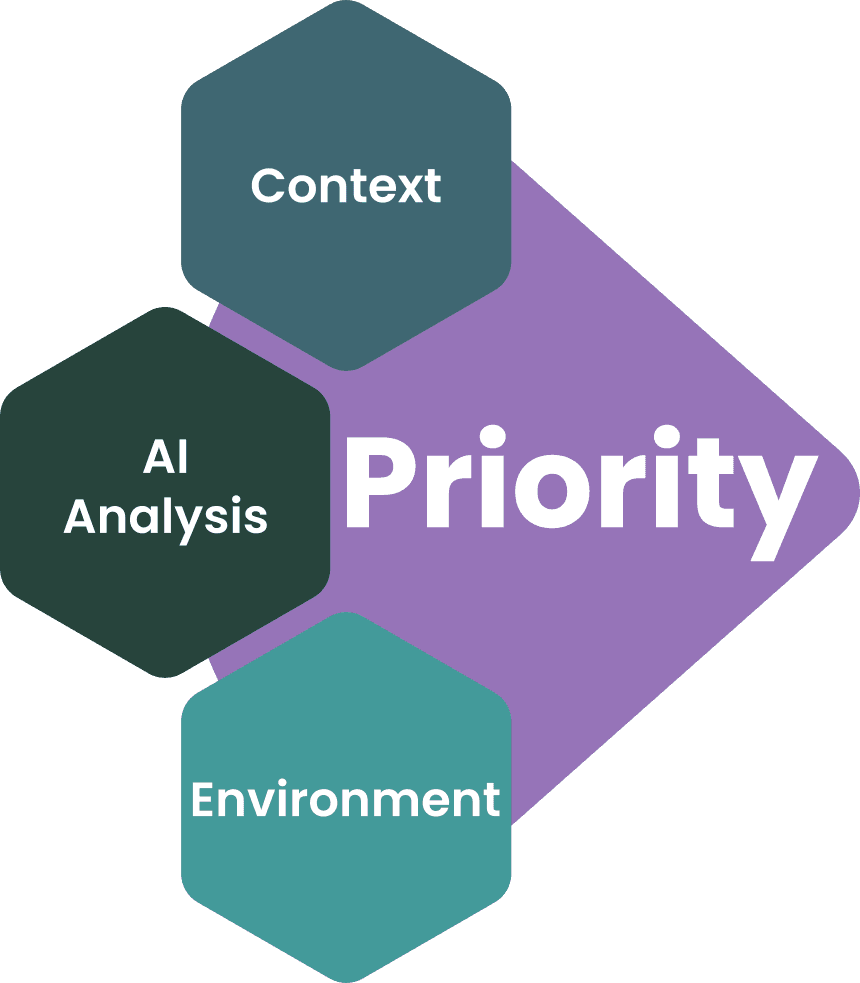Explore
Effective vulnerability analysis and prioritization require assessing each vulnerability in both external and internal contexts, aided by expert analysis. This entails looking at vulnerabilities from potential attackers' perspectives and how they might exploit weaknesses in specific attack scenarios. When prioritizing, consider internal factors such as the criticality of the affected environment. This holistic approach ensures robust vulnerability management and protection for your digital assets.

Context
Information from 3rd party sources
In vulnerability analysis, various information sources are vital for protecting digital ecosystems. Our exploit database is a valuable resource for known vulnerabilities, helping security experts understand potential threats. Social networks provide real-time insights into emerging risks, enabling quick responses. CISA KEV (Cybersecurity and Infrastructure Security Agency's Known Exploited Vulnerabilities) offers a curated list of actively exploited vulnerabilities, streamlining critical patch prioritization. Threat intelligence feeds provide continuous updates on threat actors and tactics, adding context to potential vulnerabilities. News sources contribute to situational awareness, keeping analysts well-informed about the evolving threat landscape. These resources empower security professionals to proactively identify, assess, and mitigate vulnerabilities, strengthening digital environment resilience.
Active exploitation
The Cybersecurity and Infrastructure Security Agency (CISA) maintains a valuable resource known as the 'Known Exploited Vulnerabilities Catalog'.
We are monitoring CISAs KEV catalog constantly. If a vulnerability is included within the catalog, you will be the first to know.
Social Media & News
Social media can be a vast source of information, which can be hard to navigate. Yet, it's valuable to know what others think about vulnerabilities and threats. Our system monitors social media actively, capturing discussions and updates from cybersecurity experts and organizations.It tracks popular platforms, pinpointing conversations related to vulnerabilities.
By tapping into this collective expertise, our system offers a unique and timely perspective on potential risks. Additionally, it keeps a close eye on cybersecurity news sites, providing up-to-date reports on vulnerabilities, attack methods, and ways to mitigate them.
This proactive approach helps organizations quickly assess vulnerabilities and take informed steps to protect their systems and data, bolstering their cybersecurity defense.
Exploit Database
Our curated exploit database contains various exploitation frameworks, such as Metasploit, Canvas, Core Impact, Gleg exploit pack, White phosphorus, and more, including exploits not yet integrated into any framework.
Code repositories serve as another source of exploit code. Whether it's a Proof of Concept (PoC) or fully functional exploit, we monitor public code repositories closely as soon as new code becomes available.
Vulnerability Threat Intelligence
We monitor threat reports from public sources, searching for publicly disclosed vulnerabilities used in real threat actor campaigns. For each report, we track threat actors, their targeted industries, and geographic data.
Sandbox Data
We monitor sandbox engines to detect cyberattacks and analyze how malicious actors exploit vulnerabilities in real-world situations. This aids experts in comprehending attacker tactics, gauging issue severity, and devising effective countermeasures. Sandbox data forms an important part of our vulnerability context.
AI Driven Analysis
Encapsulated Offensive Expertise
Finding security experts, especially those with offensive security backgrounds, is challenging. We ensure that even less-experienced professionals can analyze vulnerabilities effectively.
Our engine goes beyond traditional cybersecurity analysis. It maps vulnerabilities to key security frameworks, offering a complete security overview. This includes integration with MITRE ATT&CK, CAPEC, DISA, STIG, OWASP Top 10, OWASP ASVS, and WASC. This enables precise prioritization and effective defense strategies.
But we don't stop there. Our models not only identify vulnerability types and assign CVSS scores but also conduct compliance checks against common standards like NIST, PCI DSS, ISO 27001, and HIPAA.
Environment
Analysis tailored to the affected environment
After we've enriched and analyzed the data with AI, there's one crucial element missing: the environment context. The priority of a vulnerability can vary across different environments. Imagine this scenario:
A vulnerability (e.g., CVE-XXXX-XXX) is found in both publicly accessible infrastructure and an isolated Virtual Machine (VM) that only certain users can access. It's a serious vulnerability with available exploit code. Your team can only respond to one environment. Which one should you choose?
While the answer may seem clear here, imagine having to make the same decision for hundreds of vulnerabilities.
Prioritization
Get your vulnerabilities in order
Our vulnerability prioritization engine provides sensible default prioritization for vulnerabilities, which can also be customized to align with your security policies and requirements.